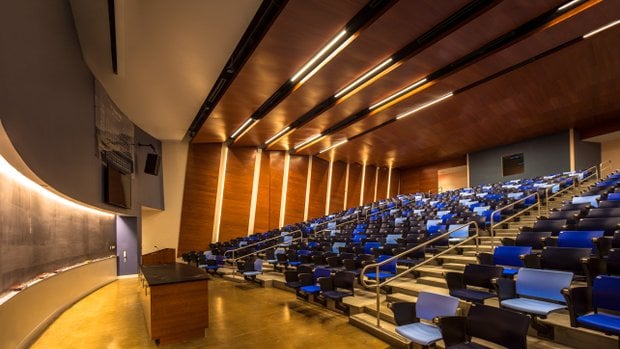Creative Work Environments Allow for Better Learning and Performance
When writing essays or working out math problems, it’s often suggested that students briefly step back from their work and let their mind mull over it. Rigid, structured work environments are not always conducive to this idea of learning. In order for universities to fulfill their purpose as a center for learning, they need to provide natural and relaxing areas that promote collaboration and discussion.
The library may be one of the most popular places to study, but it’s just not a forum for collaboration. What students need is a place as informative as a teaching assistant’s office hours yet still as social as the dorm common room. Google’s Manhattan Engineering Director Craig Nevill-Manning noted that everything in the company’s office design “was geared toward making it easy to talk.” In other words, fostering more natural communication among employees is one of the first steps toward productivity.
Perhaps Warren Lecture Hall doesn’t warrant skylights and flora, but the creation of unconventional study spaces is a plausible compromise. Students need to be able to change where they work so that they are constantly stimulated. Architecture firm Gensler has noted just how important it is for “individuals [to] have the time and space to imagine, muse, write, reflect, create and just be alone with their thoughts.”
That’s harder to do in a concrete bedroom or even in a library with windows. Stimulus is what’s necessary to learn — stimulus to think about the task at hand or even to daydream can lead to better results in the end.
— Derek Ung Staff Writer
Work Spaces Should be Dependent on the Nature of the Occupation
Henry David Thoreau went to the woods to learn and be inspired about life. According to The Atlantic, occupations that require creativity benefit from settings akin to nature, as they supposedly reduce stress. But while it can be fruitless to fit 300 plus students into a lecture hall and expect to them be inspired to learn while staring at the giant periodic table on the bleak, gray ceiling, a more freeform and natural environment is not necessarily the answer for everyone.
For many, the typical office atmosphere with a desk and cubicle keeps them from getting distracted, thus allowing them to be more productive — explaining the mass exodus to Geisel during Finals Week. High-profile businesses in the creative fields have given people more opportunity to add color to their workplace or otherwise customize their space, but there are limitations. This type of environment might be impractical for people with jobs that require order and structure, such as for a banker or judge. In regard to creative, open offices, architectural firm Gensler noted that “when focus is compromised in pursuit of collaboration, neither works well.” Several such occupations demand that employees work with efficiency and discipline, but an open space with bright colors, for example, would lead to the wandering minds that are more valuable to creative professions.
Moreover, the expenses to convert unstimulating offices to some sort of ecosystem are probably unnecessary. In the end, one type of working space is not going to accommodate everyone’s style, even if it did work for Thoreau.
— Rosina Garcia Contributing Writer
Traditionally Structured Environments Promote Focus and Efficiency
Companies like Google claim to have integrated individualism within the workplace. Citing studies on evolutionary behavior, they advocate a working environment that stresses free-form, personal space, arguing that the traditional, closed-off office space hinders productivity and discourages workers’ interaction. This has led to the question of how to apply this model outside of business, with suggestions that the sort of creativity inspired by the open office could enhance classroom learning.
But the idea of an open office already has its critics. Maria Konnikova of The New Yorker cites several studies in her post on “The Open-Office Trap,” arguing that people suffer from distraction and disorganization when removed from their structured workspaces. Forcing the new office space model into the classroom environment is not promising either. The application of business ergonomics to classroom design fails on several fronts; first and foremost in that classroom facilities are designed with listening in mind. The sort of creative freedom that the individual workspace is meant to inspire engenders a potential for distraction: email, Twitter, news and the more “pressing” things a student might find. Moreover, this model is highly space inefficient on a larger scale. In the bigger classes at UCSD, for example, a natural, ergonomic space for each student is impractical.
Far from fostering personal discovery, personalized spaces only encourage the ideas of the individual, instead of the new ideas being presented. Imposing a one-size-fits-all solution on the issue is not a great way to encourage true individuality.
— Joseph Coffey Contributing Writer








